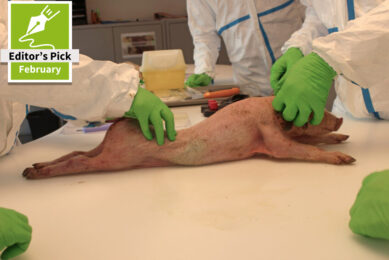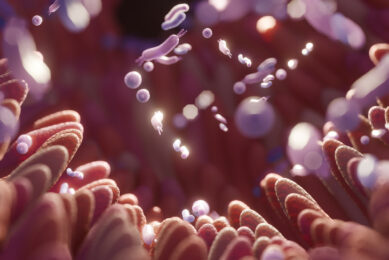The role of protein on gut health

A holistic approach combines modern nutritional concepts and gut health enabling products to support antibiotic free production. Low protein diets in combination with probiotics therefore have a role to play in supporting pig and poultry performance.
In today’s intensive commercial production systems, the maintenance of gut health is critical to achieve optimal performance. Stressful conditions can result in a suboptimal health status due to microbial imbalance in the digestive tract, thus reducing the performance to much below the animals’ genetic potential. The microbial ecosystem of the digestive tract is influenced by dietary factors and of those, one of the most important one is protein. Globally, due to the availability of supplemental amino acids (AA), the animal production industry is increasingly utilising the concept of low protein diets balanced for digestible AAs based on ideal AA ratios for various beneficial reasons.
These are:
- nutritional to improve animal performance and feed efficiency, reduce health problems such as foot pad lesions, and reduce utilisation of protein sources;
- economical to reduce diet and water cost;
- environmental to limit nitrogen excretion and ammonia emissions.
More recently, several authors have reported that feeding low crude protein (CP) diets and diets with highly digestible protein significantly reduce the C. perfringens counts in the intestine associated with decreased intestinal lesion scores in broiler chickens. Furthermore, a study conducted in Germany showed that reducing the dietary CP by ≈1% across all diets from d 1 to 40 did not have a negative impact on the growth performance, but further reduction (≈1.5%) might not be economically beneficial. Reducing dietary CP significantly reduced litter moisture, litter nitrogen and most importantly increased the number of birds without any footpad lesions.
Similarly, in pigs feeding high protein diets lead to a flow of undigested protein to the large intestine where it is fermented to produce toxic substances such as ammonia and amines that can cause post-weaning diarrhoea. In this regard, Heo (2010) demonstrated that without compromising the performance, reducing the dietary CP reduced the nitrogen excretion, while also reducing the post-weaning diarrhoea incidence in piglets under mild E. coli challenge.
Probiotic interaction with dietary protein
Disturbances in the intestinal microbial population can result in increased levels of pathogenic organisms, negatively impacting feed intake, body weight and feed conversion. Probiotics have shown to improve the development and maintenance of a stable gut microbiome, which leads to reduced enteric disease and improved growth performance. Therefore, beneficial effects of a probiotic could be attributable to better gut health resulting in better utilisation of nutrients. On the other hand, feeding high CP diets can have a negative impact on gut health due to the increased flow of indigestible protein to the large intestine, thus increasing metabolite production in the caecum. A study was conducted with an objective to determine to what extent Bacillus-based probiotics are able to ameliorate the negative effect of Clostridial challenge in chickens fed low or normal CP diets. Results from this study, as shown in Figure 1, indicate that weight gain and the feed conversion rate were significantly reduced in challenged birds, while feeding the probiotic increased weight gain, feed intake and improved feed conversion ratio. Further, caecal Ruminococcus population was higher in both non-challenge and challenging conditions but the effect was more pronounced under NE challenge.
Figure 1 – Interaction effects of dietary crude protein and probiotic supplementation on performance of broilers under NE challenge (d0-24), gut integrity and serum uric acid levels (day 16).

Feeding bacillus-based probiotics can help to re-establish the normal microflora by increasing again the Ruminococcus population that are associated with higher butyric acid production. Additionally, serum uric acid levels were lower in birds fed a low protein diet. Finally, reduction of uric acid concentration in serum of birds fed the probiotic could also be related to better utilisation of protein and AA for protein accretion, as uric acid is the major end product of protein metabolism. These findings suggest that supplementation of Bacillus-based probiotic can help to improve performance and/or gut microflora in challenged birds fed either normal or low protein diets. This positive result could be due to better gut environment and less inflammation and damage to the epithelium cells creating a stronger tight junction bond between cells.
Benefits of functional feed additives
In conclusion, feeding low crude protein diets balanced on ideal AA have positive advantage of reducing nitrogen excretion, reducing post-weaning diarrhoea in piglets and foot pad dermatitis in broiler chicken. However, under commercial conditions, due to sub-optimal health status, AA requirements might be higher than current recommendations and as result growth maybe compromised due to partitioning of more AAs towards maintenance.
Feeding functional feed additives (e.g., probiotics) can help to maintain gut health by modulating gut microbiota (e.g., Ruminococcus) and reducing pathogenic bacteria (e.g. Clostridium perfringens, Enterococcus, E. coli, etc). Therefore, reducing dietary protein in combination with probiotics might help to mitigate gut health challenges, maintain performance and contribute towards sustainable production.
References are available on request
Author: Kiran Doranalli, Technical Director, Gut Health Solution, Evonik Nutrition and Care GmbH











